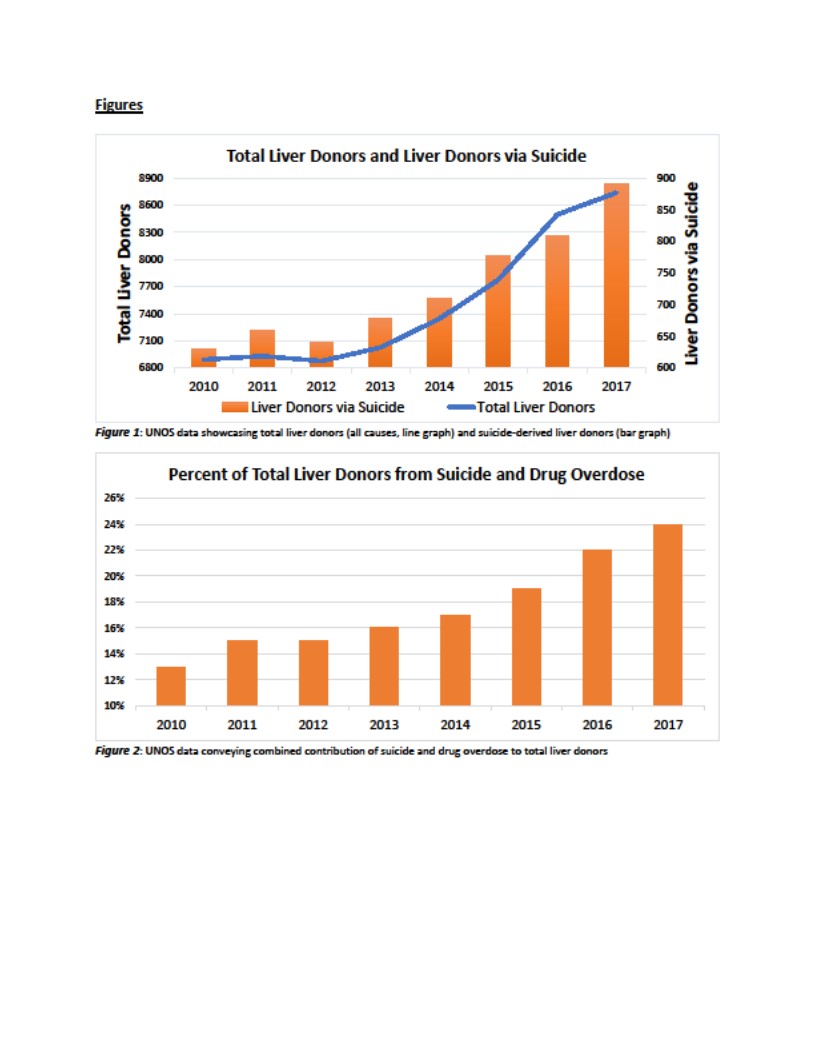Twin Epidemics: Drug Overdoses And Suicides Are Increasingly Fueling The United States Donor Liver Supply
1Baylor College of Medicine, Houston, TX, 2Southwest Transplant Alliance, Dallas, TX
Meeting: 2019 American Transplant Congress
Abstract number: C295
Keywords: Allocation, Cadaveric organs, Donation, Public policy
Session Information
Session Name: Poster Session C: Liver: MELD, Allocation and Donor Issues (DCD/ECD)
Session Type: Poster Session
Date: Monday, June 3, 2019
Session Time: 6:00pm-7:00pm
 Presentation Time: 6:00pm-7:00pm
Presentation Time: 6:00pm-7:00pm
Location: Hall C & D
*Purpose: In 2010, 6893 donor livers were procured for United States (U.S.) transplant. A reduction from the former pinnacle of U.S. liver transplant in 2006, the need for innovationin donor pool expansion was apparent. Fortunately, an unprecedented rise to 8740 liver donors materialized by the close of 2017. We continue in our attempts to decipher this growth’s basis. If we cannot attribute the donor surge to tangible grounds, expansion efforts are largely in vain.
*Methods: We previously investigated the opioid epidemic’s unforeseen contribution to liver donation. From 2002-2016, UNOS data revealed a 1115% increase in donor livers via drug overdose. An in-depth chart review of 200 consecutive donors also uncovered drug abuse in a staggering 47% of the research cohort. Nevertheless, we recognize the myriad reasons for thedonation upswing and have broadened our scope to include suicide. In part, we queried the UNOS database while analyzingall donors procured for liver transplantation (stratified by cause of death, mechanism of death, and death circumstance) in the U.S. from 2010-2017.
*Results: The suicide epidemic is garnering increasing attention in the U.S. Sadly, the 13 suicides per 100,000 people is the highest rate recorded in 28 years. The CDC reports that the suicide rate has gone up in nearly every state, and for more than half the states the increase has been greater than 30% since 1999. In Figure 1, we display total U.S. liver donation (all causes) superimposed on suicide-derived liver donation. This data illustrates suicide’s growing share of donation since 2010. There were 8740 U.S. liver transplants in 2017; 891 were from suicide victims and 1,176 were from drug overdose victims. This represents a transplant dependency of almost 25% in 2017(shown in Figure 2).
*Conclusions: Our data demonstrates 1 in 4 liver transplants are rooted in the hopefully short-term opioid and suicide epidemics. As society struggles to eliminate preventable tragedy, its significant contribution to organ donation must be replaced with durable solutions. With most estimates suggesting that we only capture 1 in 2 eligible donors, we must launch creative strategies to seize all viable donor organs.
To cite this abstract in AMA style:
Goss M, Kueht M, Galvan N, Reece J, Rana A. Twin Epidemics: Drug Overdoses And Suicides Are Increasingly Fueling The United States Donor Liver Supply [abstract]. Am J Transplant. 2019; 19 (suppl 3). https://atcmeetingabstracts.com/abstract/twin-epidemics-drug-overdoses-and-suicides-are-increasingly-fueling-the-united-states-donor-liver-supply/. Accessed December 24, 2025.« Back to 2019 American Transplant Congress

